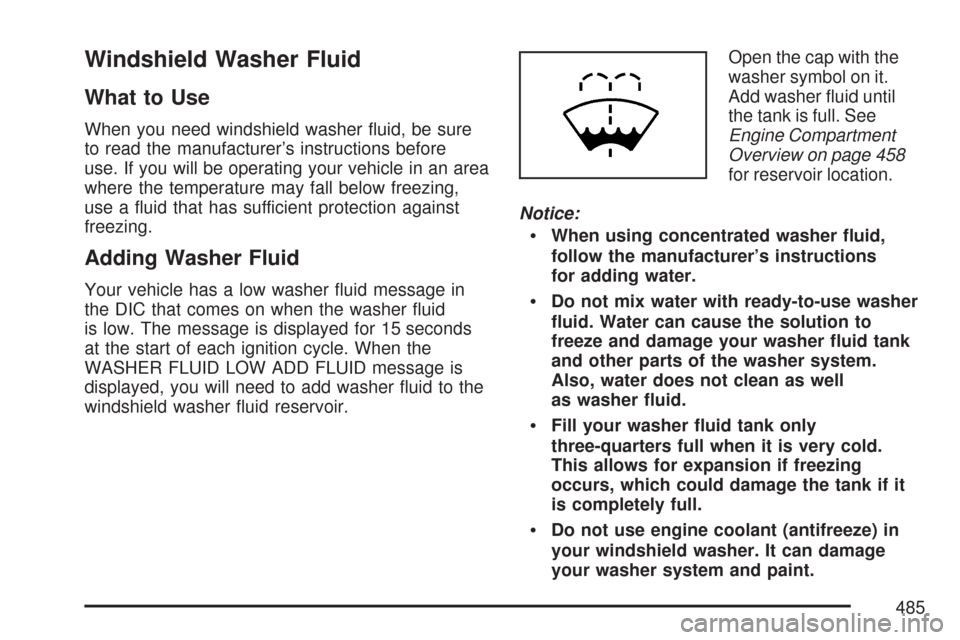Page 144 of 634

To Use the Engine Coolant Heater
1. Turn off the engine.
2. Open the hood and unwrap the electrical
cord. The cord is located on the driver’s
side of the engine compartment, near
the power steering �uid reservoir.
3. Plug the cord into a normal, grounded
110-volt AC outlet.
{CAUTION:
Plugging the cord into an ungrounded
outlet could cause an electrical shock.
Also, the wrong kind of extension cord
could overheat and cause a �re. You
could be seriously injured. Plug the cord
into a properly grounded three-prong
110-volt AC outlet. If the cord will not
reach, use a heavy-duty three-prong
extension cord rated for at least 15 amps.4. Before starting the engine, be sure to unplug
and store the cord as it was before to keep it
away from moving engine parts. If you do
not, it could be damaged.
How long should you keep the coolant heater
plugged in? The answer depends on the outside
temperature, the kind of oil you have, and
some other things. Instead of trying to list
everything here, we ask that you contact your
dealer in the area where you will be parking your
vehicle. The dealer can give you the best
advice for that particular area.
144
Page 459 of 634

A. Engine Air Cleaner/Filter. SeeEngine Air
Cleaner/Filter on page 464.
B. Air Filter Restriction Indicator (If Equipped).
SeeEngine Air Cleaner/Filter on page 464.
C. Coolant Surge Tank and Pressure Cap.
SeeCooling System on page 477andCoolant
Surge Tank Pressure Cap on page 473.
D. Remote Positive (+) Terminal. SeeJump
Starting on page 491.
E. Battery. SeeBattery on page 490.
F. Engine Oil Fill Cap. See “When to Add Engine
Oil” underEngine Oil on page 459.
G. Automatic Transmission Dipstick. See
“Checking the Fluid Level” underAutomatic
Transmission Fluid on page 466.
H. Remote Negative (−) Terminal (Out of View).
SeeJump Starting on page 491.
I. Engine Oil Dipstick (Out of View). See
“Checking Engine Oil” underEngine Oil on
page 459.
J. Engine Cooling Fan. SeeCooling System on
page 477.
K. Power Steering Fluid Reservoir. SeePower
Steering Fluid on page 484.L. Brake Master Cylinder Reservoir. See “Brake
Fluid” underBrakes on page 486.
M. Underhood Fuse Block. SeeUnderhood Fuse
Block on page 567.
N. Windshield Washer Fluid Reservoir. See
“Adding Washer Fluid” underWindshield
Washer Fluid on page 485.
Engine Oil
If the CHECK OIL LEVEL message in the Driver
Information Center (DIC) comes on, check the
engine oil level right away. For more information,
see CHECK OIL LEVEL underDIC Warnings and
Messages on page 270. You should check the
engine oil level regularly; this is an added reminder.
Checking Engine Oil
It is a good idea to check the engine oil every time
you get fuel. In order to get an accurate reading,
the oil must be warm and the vehicle must be
on level ground.
459
Page 485 of 634

Windshield Washer Fluid
What to Use
When you need windshield washer �uid, be sure
to read the manufacturer’s instructions before
use. If you will be operating your vehicle in an area
where the temperature may fall below freezing,
use a �uid that has sufficient protection against
freezing.
Adding Washer Fluid
Your vehicle has a low washer �uid message in
the DIC that comes on when the washer �uid
is low. The message is displayed for 15 seconds
at the start of each ignition cycle. When the
WASHER FLUID LOW ADD FLUID message is
displayed, you will need to add washer �uid to the
windshield washer �uid reservoir.Open the cap with the
washer symbol on it.
Add washer �uid until
the tank is full. See
Engine Compartment
Overview on page 458
for reservoir location.
Notice:
When using concentrated washer �uid,
follow the manufacturer’s instructions
for adding water.
Do not mix water with ready-to-use washer
�uid. Water can cause the solution to
freeze and damage your washer �uid tank
and other parts of the washer system.
Also, water does not clean as well
as washer �uid.
Fill your washer �uid tank only
three-quarters full when it is very cold.
This allows for expansion if freezing
occurs, which could damage the tank if it
is completely full.
Do not use engine coolant (antifreeze) in
your windshield washer. It can damage
your washer system and paint.
485
Page 586 of 634

(k)Inspect system. Check all fuel and vapor lines
and hoses for proper hook-up, routing, and
condition. Check that the purge valve works
properly, if equipped. Replace as needed.
(l)If you drive regularly under dusty conditions,
inspect the �lter at each engine oil change.
(m)Visually inspect belt for fraying, excessive
cracks, or obvious damage. Replace belt if
necessary.
Owner Checks and Services
These owner checks and services should be
performed at the intervals speci�ed to help ensure
the safety, dependability, and emission control
performance of your vehicle. Your GM
Goodwrench
®dealer can assist you with these
checks and services.
Be sure any necessary repairs are completed at
once. Whenever any �uids or lubricants are added
to your vehicle, make sure they are the proper
ones, as shown inRecommended Fluids and
Lubricants on page 590.
At Each Fuel Fill
It is important to perform these underhood checks
at each fuel �ll.
Engine Oil Level Check
Check the engine oil level and add the proper oil if
necessary. SeeEngine Oil on page 459for
further details.
Notice:It is important to check the engine oil
regularly and keep it at the proper level.
Failure to keep the engine oil at the proper
level can cause damage to the engine not
covered by your warranty.
Engine Coolant Level Check
Check the engine coolant level and add
DEX-COO®coolant mixture if necessary. See
Engine Coolant on page 470for further details.
Windshield Washer Fluid Level Check
Check the windshield washer �uid level in
the windshield washer �uid reservoir and add the
proper �uid if necessary.
586